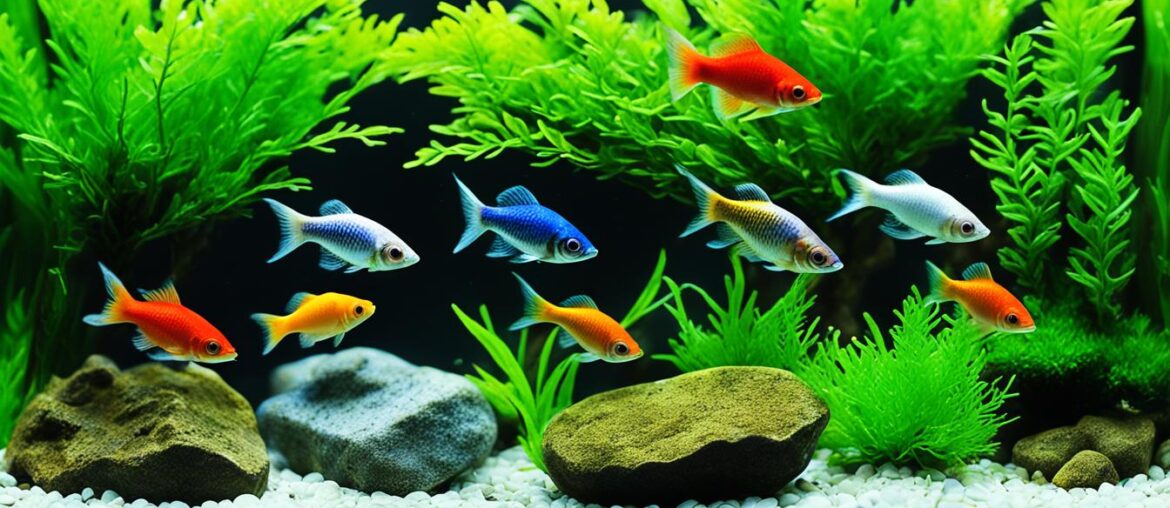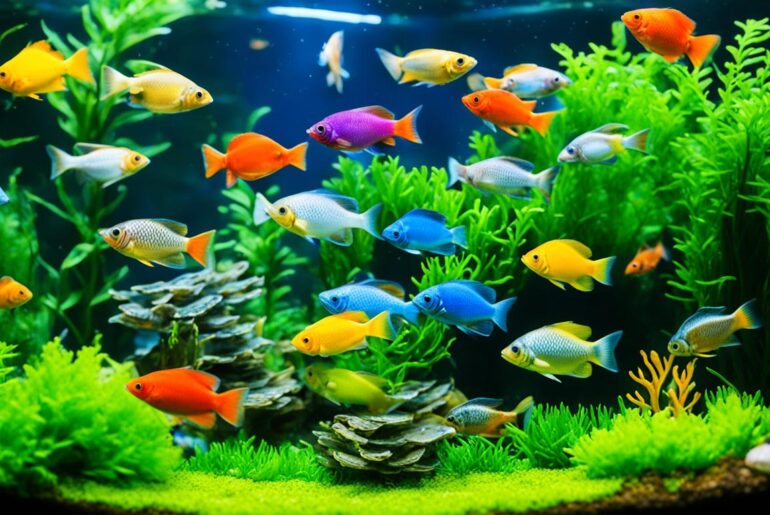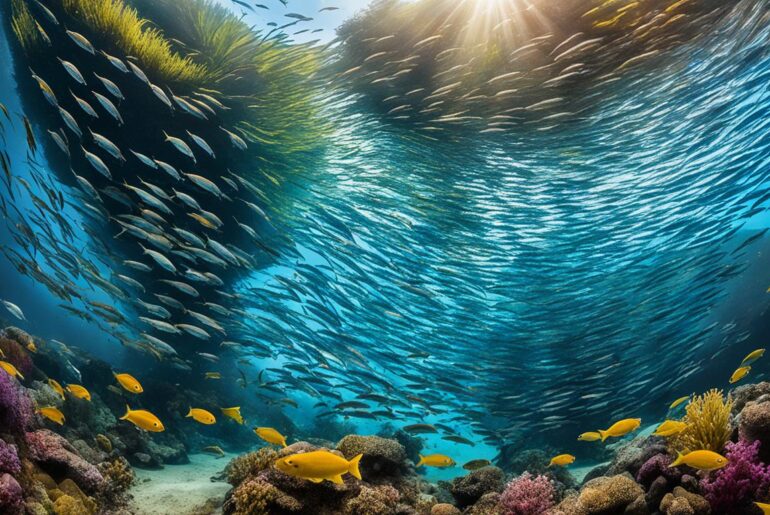If you’re looking to add life and vibrancy to your nano tank, there are several small freshwater fish species that are perfect for these compact aquariums. In this guide, I’ll introduce you to seven ideal options that are suitable for nano tanks and provide information on their care requirements and characteristics. These small fish will bring beauty and excitement to your miniature aquatic world.
Key Takeaways:
- Small freshwater fish for nano tanks can add life and vibrancy to your miniature aquatic world.
- Harlequin Rasbora, Otocinclus, Least Killifish, Bumblebee Goby, Scarlet Badis, Neon Tetra, and Betta Fish are ideal options for nano tanks.
- Each fish species has unique care requirements and characteristics.
- Consider the size of your nano tank and the compatibility of the fish before making a selection.
- Small freshwater fish provide a beautiful and vibrant display in nano tanks.
Harlequin Rasbora
The Harlequin Rasbora is a popular choice for nano tanks due to its small size and striking appearance. These fish are native to Southeast Asia and are known for their pinkish-orange body color with a bold black triangle-shaped patch on their lower half. Harlequin Rasboras are shoaling fish and should be kept in groups of six or more to ensure their well-being. They are suitable for beginner aquarists and can thrive in nano tanks with a minimum size of 10 gallons.
If you’re looking to add some vibrant colors to your nano tank, the Harlequin Rasbora is an excellent choice. With its unique body pattern and peaceful nature, it can be the perfect centerpiece for your mini aquatic world. Let’s take a closer look at this beautiful fish and why it’s a great addition to your nano tank.
| Characteristic | Details |
|---|---|
| Common Name | Harlequin Rasbora |
| Scientific Name | Trigonostigma heteromorpha |
| Origin | Southeast Asia |
| Size | 1.5 inches (3.8 cm) |
| Coloration | Pinkish-orange body with a bold black triangular patch |
| Compatibility | Peaceful, suitable for community tanks |
| Shoaling | Yes, keep in groups of 6 or more |
| Tank Size | Minimum 10 gallons |
| Diet | Omnivorous, flake food, live or frozen food, and small insects |
| Water Parameters | Temperature: 73-82°F (23-28°C), pH: 6.0-7.0 |
Appearance
The Harlequin Rasbora’s vibrant pinkish-orange body color instantly captures attention. Its standout feature is the bold black triangular patch that extends from the base of the dorsal fin to the tail. This unique pattern creates a visually striking contrast against the fish’s bright body color. With its elegant shape and lively colors, the Harlequin Rasbora adds a touch of beauty to any nano tank.
Behavior and Compatibility
Harlequin Rasboras are peaceful and non-aggressive fish, making them an excellent choice for nano tanks and community setups. They enjoy the company of their own kind and should be kept in groups of six or more. By providing a suitable shoaling environment, you can observe their natural behavior as they swim and explore together, creating a sense of harmony in your nano tank.
Care and Tank Requirements
Harlequin Rasboras are beginner-friendly fish, as they are relatively easy to care for. They prefer a well-maintained aquarium with clean water and stable water parameters. A nano tank with a minimum size of 10 gallons can accommodate a small group of Harlequin Rasboras comfortably.
Decorate your nano tank with live plants, rocks, and driftwood to provide hiding spots and mimic their natural habitat. Adding floating plants can help diffuse bright lighting and create a more natural environment for the fish.
As omnivorous fish, Harlequin Rasboras have a diet that consists of both plant matter and small insects. You can feed them high-quality flake food, as well as supplement their diet with live or frozen food such as brine shrimp, daphnia, or bloodworms.
Water Parameters
The ideal water temperature for Harlequin Rasboras ranges from 73-82°F (23-28°C), and the pH level should be around 6.0-7.0. Maintain good water quality by performing regular water changes and using a reliable filtration system to provide a healthy and stable environment for your fish.
Remember to acclimate new fish properly to minimize stress and ensure a smooth transition into their new home. Always follow proper quarantine procedures to prevent the introduction of diseases to your nano tank.
Pro tip: To create a visually appealing nano tank, consider adding other small fish species and compatible aquatic plants. The Harlequin Rasbora’s vibrant colors and peaceful nature make it an excellent choice for creating a vibrant and harmonious aquatic community in your nano tank.
Otocinclus
When it comes to stocking your nano tank with the perfect inhabitants, consider the Otocinclus, also known as dwarf suckers. These small catfish bring a unique charm to your miniature aquatic world while fulfilling an essential role as efficient algae eaters.
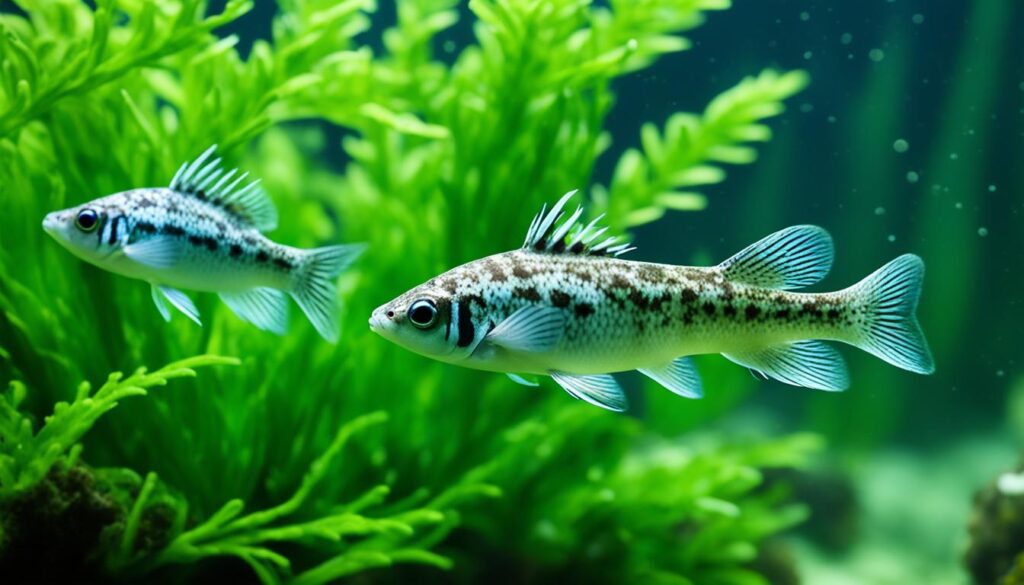
What sets Otocinclus apart is their distinctive appearance, with their expansive mouths and ability to cling onto surfaces. You’ll often find them attached to the sides of the tank or grazing on plant leaves. Their herbivorous nature makes them valuable contributors to the tank’s ecosystem, helping to control algae growth and maintain a clean environment.
Otocinclus primarily feed on algae, continuously grazing on surfaces and keeping them free from unwanted growth. However, they also appreciate a varied diet, which can include blanched vegetables and algae wafers. This ensures their nutritional needs are met and promotes their overall well-being.
These peaceful nano tank-friendly fish thrive best when kept in groups. Due to their small size, they require a minimum tank size of 10 gallons to provide ample swimming space and maintain water quality. Otocinclus are known to be compatible with various tank mates, making them an excellent addition to community nano tanks.
In summary, if you’re seeking an algae-eating fish with a unique appearance and peaceful demeanor, Otocinclus is the ideal choice for your nano aquarium. These herbivorous dwarf suckers will contribute to the health and aesthetic appeal of your tank while fostering a harmonious aquatic environment.
Least Killifish
When it comes to small freshwater fish for nano tanks, the Least Killifish, also known as dwarf livebearers, is a fantastic choice. These native southern United States fish are perfect for nano tanks due to their small size and peaceful nature. They only reach a maximum length of 1.5 inches, making them an ideal addition to compact aquarium setups.
Least Killifish are known for their unique group behaviors and shoaling tendencies. They thrive when kept in small colonies, spending a lot of time together. Their shy nature adds an air of mystique to your nano tank, as they move together in synchronized patterns.
Caring for Least Killifish is a breeze, which makes them suitable for beginners. They are hardy and adaptable, and can tolerate a wide range of water parameters. These livebearers are generally undemanding when it comes to their diet and can thrive on a varied diet of small pellets, flakes, and live or frozen foods.
Considering their small size and social nature, Least Killifish only require a nano tank with a minimum size of 5 gallons. However, for optimal comfort and space, it’s recommended to provide them with a slightly larger tank if possible. Adding some live plants, hiding spots, and gentle water flow will help recreate their natural habitat and provide them with a secure environment.
Comparison of Nano Fish Species
| Fish | Size | Behavior | Tank Size |
|---|---|---|---|
| Harlequin Rasbora | 0.8-1.2 inches | Shoaling | 10 gallons |
| Otocinclus | 1.5 inches | Peaceful shoaling | 10 gallons |
| Least Killifish | 1.5 inches | Shoaling | 5 gallons |
| Bumblebee Goby | 1-1.5 inches | Bottom-dwelling | 10 gallons |
| Scarlet Badis | 0.8-1 inch | Predatory | 10 gallons |
| Neon Tetra | 0.8-1 inch | Schooling | 10-20 gallons |
| Betta Fish | 2-3 inches | Centerpiece | 5-10 gallons |
| Cardinal Tetra | 1-1.5 inches | Schooling | 15-20 gallons |
| Fancy Guppies | 1-2 inches | Livebearers | 5-10 gallons |
As you can see from the comparison table above, the Least Killifish fits perfectly into the nano tank category, alongside other small freshwater fish species. Whether you’re a beginner or an experienced aquarist, the Least Killifish is a wonderful addition to your nano tank, bringing beauty and a touch of nature to your aquatic environment.
Bumblebee Goby
The Bumblebee Goby is a unique and visually striking fish that is suitable for nano tanks. These small fish, named after their yellow and black stripes, are peaceful and prefer to stay at the bottom of the tank. They are brackish water fish and require a bit of marine salt in their environment to thrive. Bumblebee Gobies can be kept in nano tanks with a minimum size of 10 gallons, and it’s important to replicate their natural brackish water habitat for their health.
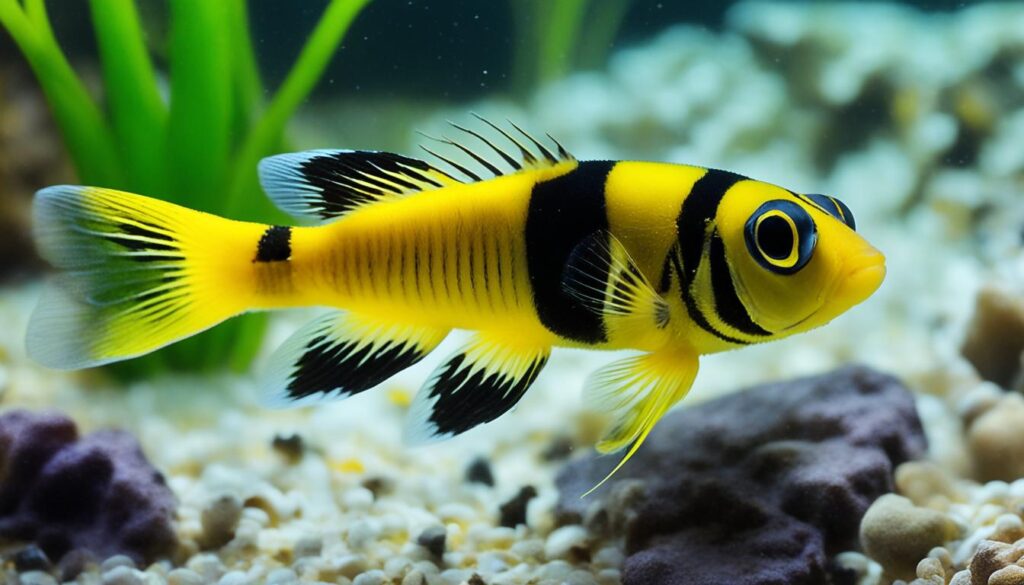
Key Characteristics of Bumblebee Gobies
- Size: Small, typically around 2 inches in length
- Coloration: Distinctive yellow and black stripes
- Behavior: Peaceful, bottom-dwelling fish
- Water Conditions: Brackish water with a bit of marine salt
- Tank Size: Minimum 10-gallon nano tank
Bumblebee Gobies are fascinating additions to any nano tank setup. Their striking appearance and peaceful nature make them a popular choice for aquarists looking to add a unique touch to their mini aquatic world. It’s important to provide them with the appropriate water conditions to ensure their well-being and replicate their natural habitat. With the right care, these small brackish water fish will thrive and bring a burst of color to your nano tank.
Scarlet Badis
The Scarlet Badis is a popular choice for nano tanks due to its vibrant colors and small size. These fish have a striking appearance with their orange or red body color, darker vertical stripes, and neon blue accents on their fins. Scarlet Badis are peaceful but considered micro predators, as they hunt for insect larvae and tiny crustaceans. It’s important to note that they may eat ornamental shrimp, so they should not be kept together. Scarlet Badis thrive in nano tanks with a minimum size of 10 gallons.
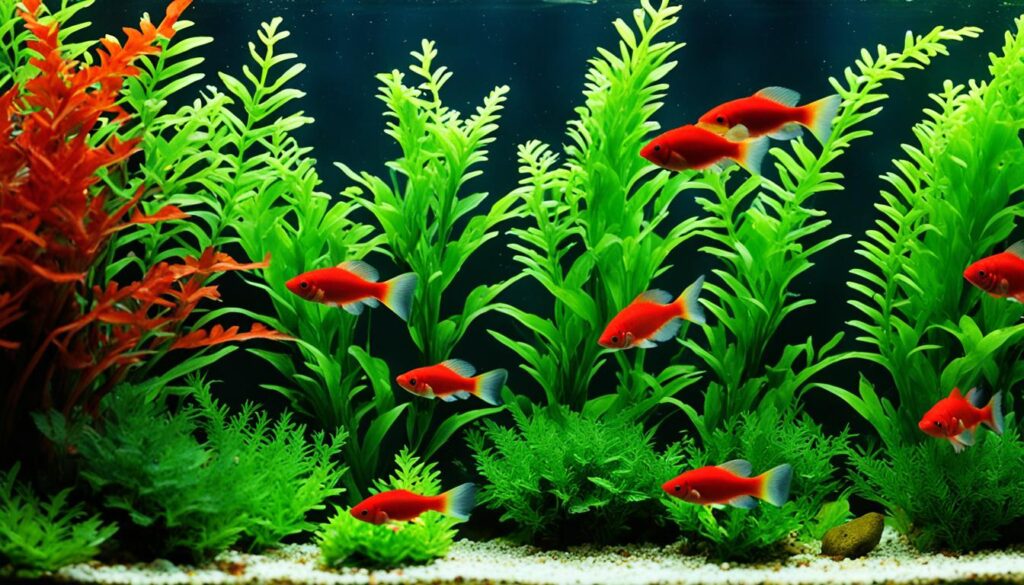
Characteristics of Scarlet Badis:
- Vibrant colors: The Scarlet Badis has a beautiful orange or red body color with darker vertical stripes and neon blue accents on its fins.
- Small size: These fish are small in size, making them ideal for nano tanks.
- Micro predators: Scarlet Badis hunt for insect larvae and tiny crustaceans, adding a natural predatory behavior to the aquarium.
- Peaceful nature: While they are predators, Scarlet Badis are generally peaceful and can coexist with compatible tank mates.
- Minimum tank size: They thrive in nano tanks with a minimum size of 10 gallons, providing them with enough space to swim and explore.
“The Scarlet Badis adds a burst of color and activity to any nano tank setup. Its striking appearance and predatory nature make it a fascinating fish to observe. Just remember to avoid keeping them with ornamental shrimp to ensure the harmony of your aquatic community.” – Aquarium Expert
Neon Tetra
The Neon Tetra is a well-known and popular choice for aquarium enthusiasts, including nano tank owners. These small fish have vibrant blue and red stripes on their body, creating a beautiful display in the tank. Neon Tetras are schooling fish and should be kept in groups of six or more. They are easy to care for and can thrive in nano tanks with a minimum size of 10-20 gallons. Their playful nature and striking colors make them a joy to watch in a nano tank setting.
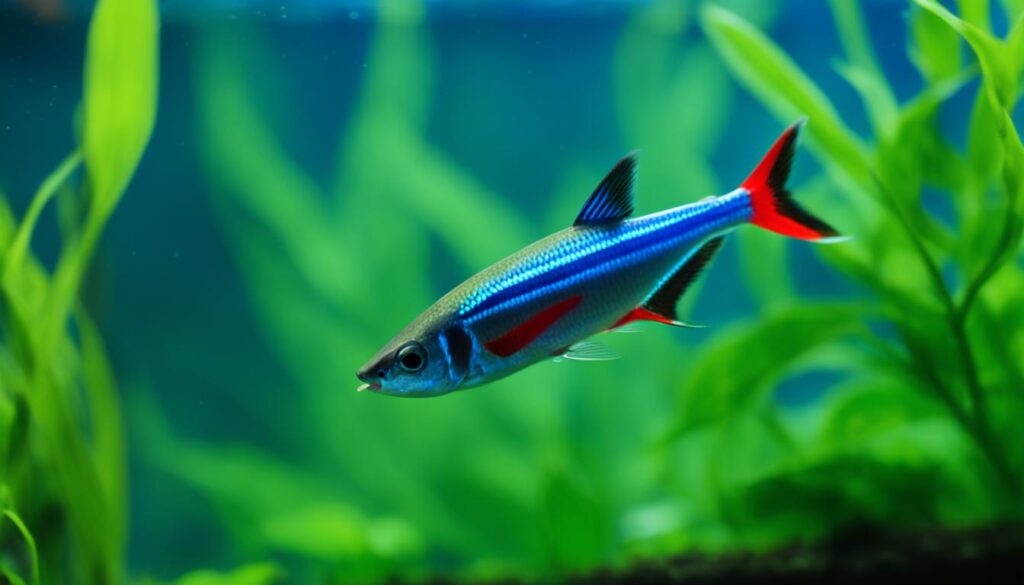
Key Features of Neon Tetra:
- Small size with vibrant blue and red stripes
- Schooling fish that should be kept in groups of six or more
- Easy to care for and suitable for beginner fishkeepers
- Ideal for nano tanks with a minimum size of 10-20 gallons
Neon Tetras are known for their stunning colors and lively behavior, making them a popular choice for nano tanks. Their small size allows them to thrive in compact environments, while their schooling nature adds a sense of movement and community to the tank. Whether you’re a beginner aquarist or an experienced enthusiast, the Neon Tetra is sure to bring beauty and enjoyment to your nano tank setup.
Betta Fish
Betta fish, also known as Siamese fighting fish, are renowned for their beauty and unique behavior. These small fish come in various colors and patterns, with males often displaying long flowing fins. While they are known to be aggressive towards other fish and may require individual housing, Betta fish can thrive in nano tanks with a minimum size of 5 to 10 gallons. It’s important to provide them with a clean environment and maintain water conditions to prevent diseases such as fin rot.
There are a few key considerations when keeping Betta fish in a nano tank. Firstly, their aggressive nature means that they should not be kept with other small fish, as they may attack or injure them. Secondly, proper filtration and regular water changes are essential for maintaining good water quality. Betta fish are particularly sensitive to poor water conditions, and dirty water can lead to stress, illness, and disease.
When setting up a nano tank for Betta fish, it’s important to create a suitable and stimulating environment. Adding floating plants, leaf hammocks, and hiding places can provide shelter and enrichment for these fish. Decorations such as rocks, driftwood, and caves also help create a sense of territory and security for Betta fish.
Feeding Betta fish in a nano tank is relatively straightforward. They are carnivorous and require a diet rich in protein. High-quality pellet or flake food specifically formulated for Betta fish should be the staple of their diet. Additionally, offering occasional treats such as frozen or live foods like bloodworms or brine shrimp can provide variety and additional nutrients.
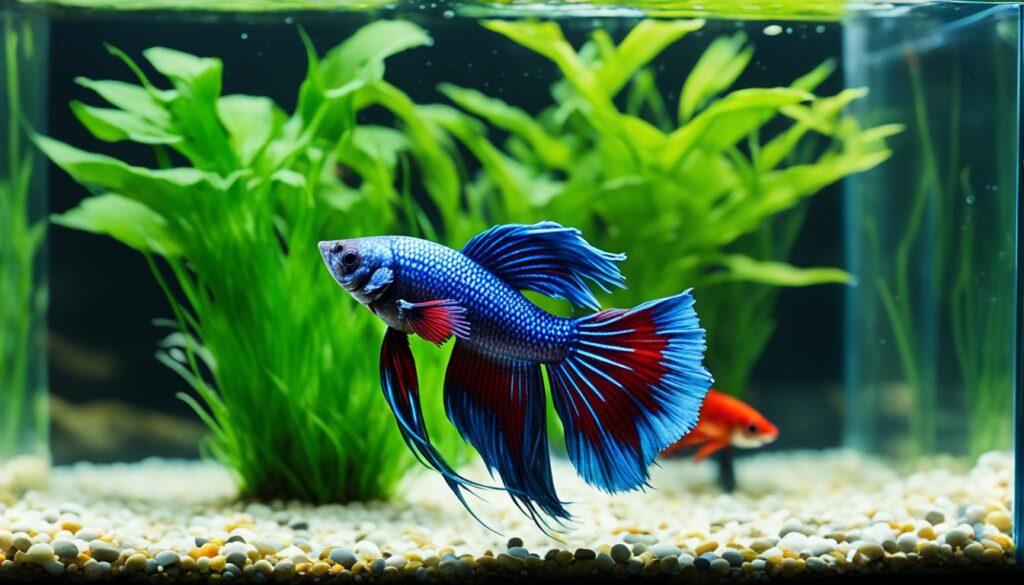
Key Points about Betta Fish in Nano Tanks:
- Betta fish are small, colorful fish known for their beauty and unique behavior.
- They require individual housing due to their aggressive nature.
- Nano tanks with a minimum size of 5 to 10 gallons can accommodate Betta fish.
- Providing a clean environment and maintaining water conditions are crucial for their well-being.
- Decorations and hiding places can create a suitable and stimulating environment for Betta fish.
- They should be fed a diet rich in protein, with high-quality pellet or flake food as the staple.
Betta fish, with their stunning colors and captivating personalities, make excellent centerpiece fish for nano tanks. However, it’s important to handle them with care and ensure their specific needs are met for them to thrive in a nano tank environment.
Cardinal Tetra
The Cardinal Tetra is a beautiful and vibrant small freshwater fish that is perfect for nano tanks. While they share similar blue and red coloration with the Neon Tetra, the Cardinal Tetra is a separate species. These tiny fish are schooling species, which means they prefer to live in groups. Keeping them in groups enhances their overall health and happiness.
Cardinal Tetras thrive in natural environments that provide plenty of organic hiding places. This can include floating plants, driftwood, and rock caves. These hiding places provide a sense of security and mimic their natural habitat.
When it comes to tank size, Cardinal Tetras require a minimum tank size of 15-20 gallons to ensure they have enough space to swim and thrive. It’s important to maintain the recommended water conditions for Cardinal Tetras. They prefer slightly acidic water with a pH level between 5.0 to 7.0 and a temperature range of 72°F to 80°F.

Cardinal Tetras are beginner-friendly fish, making them suitable for aquarists who are new to nano tank keeping. They are relatively easy to care for and can adapt well to a variety of water conditions, as long as the parameters are within the recommended range.
“The vibrant colors and graceful swimming movements of Cardinal Tetras make them a captivating addition to any nano tank.” – I
In addition to their beauty, Cardinal Tetras are peaceful fish that get along well with other non-aggressive species. However, it’s important to note that they may become anxious or stressed if kept with aggressive or larger fish.
If you’re a beginner looking to add a splash of color and liveliness to your nano tank, consider introducing a school of Cardinal Tetras. Their striking colors, schooling behavior, and ease of care make them an excellent choice for nano tank enthusiasts.
Fancy Guppies
Fancy Guppies are a popular choice for nano tanks due to their striking colors and patterns, which can add a vibrant and eye-catching element to your aquarium. Their long-flowing tails make them especially captivating, creating a stunning display of color as they gracefully swim through the water. With a wide variety of colors and patterns available, ranging from vibrant reds and blues to delicate pastels, Fancy Guppies offer endless possibilities for customization and personalization in your nano tank.
These small freshwater fish are well-suited for nano tanks and can thrive in a compact environment. They have a peaceful nature and prefer to stay towards the top of the water column, adding a lively presence to the upper levels of your tank. This makes them an excellent choice for nano tank enthusiasts who want to create an engaging and visually appealing display.
Another advantage of Fancy Guppies is that they are livebearers, meaning that instead of laying eggs, they give birth to fully-formed baby fish. This reproductive method adds an extra level of fascination to their presence in the tank, as you may witness the arrival of new generations of guppies. However, it’s important to note that guppy fry are often vulnerable to predation, so providing adequate hiding places or a separate breeding tank may be necessary to ensure their survival.
When it comes to tank requirements, Fancy Guppies can thrive in nano tanks with a minimum size of 5-10 gallons. Despite their small size, they are active swimmers and appreciate having enough space to explore and move around. It’s essential to maintain appropriate water quality and temperature, as well as provide a well-balanced diet to ensure their health and longevity.
In conclusion, Fancy Guppies are an excellent choice for nano tanks, offering a combination of stunning colors, lively behavior, and fascinating reproductive habits. Their small size and peaceful nature make them suitable for both beginner and experienced fishkeepers. By selecting a variety of Fancy Guppies with different colors and patterns, you can create a visually captivating miniature aquatic world that will impress and delight all who observe it.
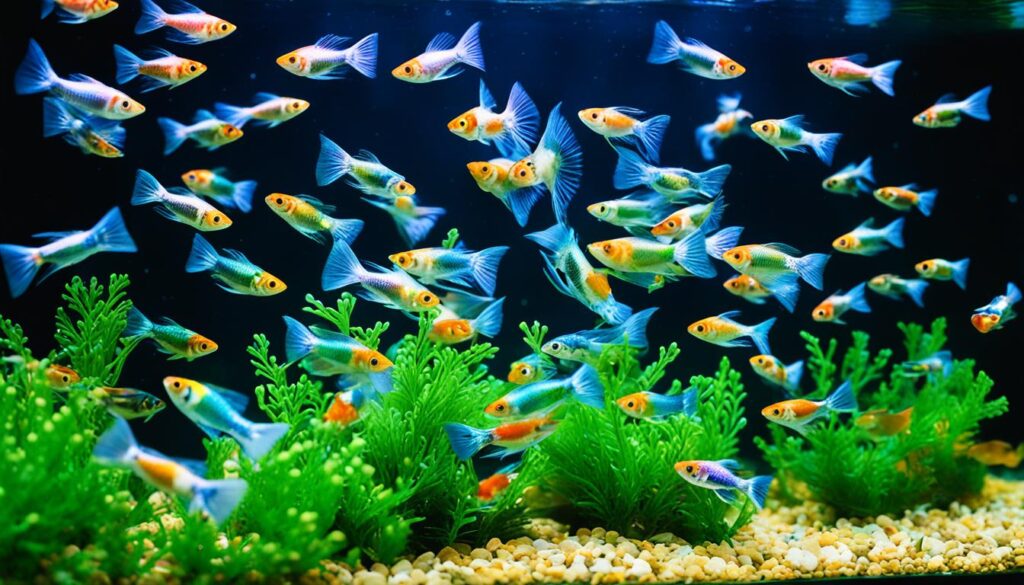
Additional Fish Options for Planted Nano Tanks
In addition to the previously mentioned fish, there are several other small freshwater fish species that could be suitable for planted nano tanks. These fish have unique characteristics and can add beauty and interest to a planted nano tank.
Celestial Pearl Danio
The Celestial Pearl Danio, also known as the Galaxy Rasbora, is a small fish native to Southeast Asia. It features stunning blue and red colors, resembling a galaxy in the tank. These fish are peaceful and prefer to be kept in small groups, making them an excellent choice for planted nano tanks.
Kerri Blue Emperor Tetra
The Kerri Blue Emperor Tetra is a strikingly beautiful fish with vibrant blue and silver colors. They are peaceful and can be kept in groups, adding a touch of elegance to the planted nano tank. These tetras prefer well-structured tanks with plenty of plants and hiding spots.
Green Kubotai Rasboras
The Green Kubotai Rasboras, also known as Emerald Dwarf Rasboras, are tiny fish with bright green and gold colors. They are peaceful schooling fish that create a lively atmosphere in a planted nano tank. These rasboras thrive in tanks with plenty of plants, open swimming space, and dim lighting.
Galaxy Koi Betta
The Galaxy Koi Betta is a unique and mesmerizing betta fish variant with stunning colors reminiscent of a galaxy. These centerpiece fish are hardy and can thrive in a planted nano tank. However, it’s important to provide them with ample space and hiding spots to minimize stress.
Midnight Black Moscow Guppies
The Midnight Black Moscow Guppies are elegant and sophisticated small fish with a black coloration that resembles the night sky. They are peaceful livebearers and can be kept in small colonies in a planted nano tank. These guppies are sure to captivate with their beauty and graceful movement.
Medaka Platinum Blue Ricefish
The Medaka Platinum Blue Ricefish, also known as the Oryzias latipes, is a small and peaceful fish that can thrive in a planted nano tank. Its shimmering platinum blue coloration adds a touch of elegance to the tank. These ricefish prefer tanks with dense vegetation and gentle water movement.
Orange Speckled Mickey Mouse Platy
The Orange Speckled Mickey Mouse Platy is a vibrant fish with a bright orange color and unique black speckles. These active and peaceful fish are easy to care for and can be kept in planted nano tanks. They are livebearers and can reproduce quickly, providing an abundance of life in the tank.
Rocket Clown Killifish
The Rocket Clown Killifish is a small and colorful fish that adds excitement to a planted nano tank. With its vibrant red, orange, and blue colors, it creates a stunning visual display. These killifish are peaceful and can be kept in small groups, bringing energy and movement to the tank.
Borneo Sucker Loach
The Borneo Sucker Loach is a fascinating bottom-dwelling fish that helps keep the tank clean by feasting on algae and leftover food. They have a unique appearance with their elongated body and sucker-like mouth. These loaches prefer well-established planted nano tanks with hiding spots and gentle water flow.
| Fish Species | Size | Temperament | Tank Size | Special Requirements |
|---|---|---|---|---|
| Celestial Pearl Danio | 1 inch | Peaceful | 10 gallons | Plenty of plants and open swimming space |
| Kerri Blue Emperor Tetra | 1.5 inches | Peaceful | 15 gallons | Well-structured tank with hiding spots |
| Green Kubotai Rasboras | 0.8 inches | Peaceful | 10 gallons | Plenty of plants and dim lighting |
| Galaxy Koi Betta | 2 inches | Semi-aggressive | 10 gallons | Ample space and hiding spots |
| Midnight Black Moscow Guppies | 1.5 inches | Peaceful | 5 gallons | Plants and open swimming space |
| Medaka Platinum Blue Ricefish | 1 inch | Peaceful | 10 gallons | Dense vegetation and gentle water movement |
| Orange Speckled Mickey Mouse Platy | 2.5 inches | Peaceful | 10 gallons | Plants and hiding spots |
| Rocket Clown Killifish | 1.5 inches | Peaceful | 10 gallons | Plants and open swimming space |
| Borneo Sucker Loach | 3 inches | Peaceful | 10 gallons | Hiding spots and gentle water flow |
These additional fish options provide a wide range of choices for planted nano tanks. Whether you’re looking for centerpiece fish or schooling fish, there’s a small freshwater fish species that will perfectly complement your planted nano tank and create a visually stunning aquatic ecosystem.
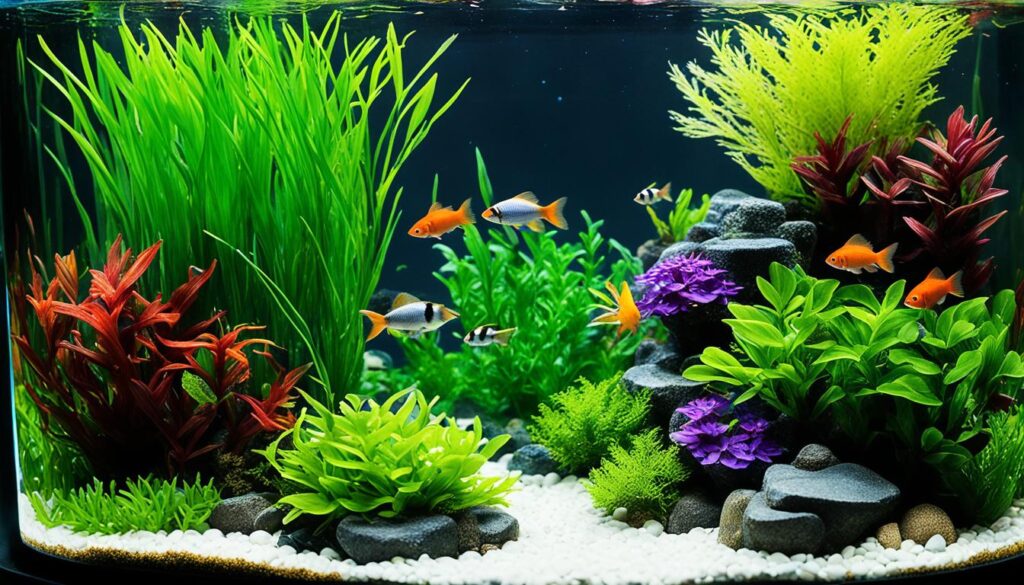
Conclusion
Nano tanks offer a unique opportunity to create a beautiful and vibrant underwater world with small freshwater fish. The seven small fish species mentioned in this guide, along with the additional fish options, are excellent choices for nano tanks due to their small size, vibrant colors, and compatibility with compact environments.
Whether you choose a centerpiece fish like the Betta or a group of schooling fish like the Neon Tetras, these small freshwater fish will bring life and beauty to your nano tank setup. Their small size makes them suitable for smaller tanks, while their striking colors and unique characteristics will add interest to your aquatic display.
Remember to provide the appropriate tank size, water conditions, and care requirements for each species. Creating a suitable habitat for your nano fish will ensure their health and well-being. With proper care and attention, your nano tank can become a captivating mini ecosystem that will bring joy and tranquility to any space.
So, whether you’re a beginner or an experienced aquarium enthusiast, consider adding these small freshwater fish to your nano tank. Enjoy the mesmerizing beauty of these tiny aquatic creatures and immerse yourself in the wonders of the underwater world. Happy fishkeeping!
FAQ
What are some small freshwater fish species suitable for nano tanks?
Some small freshwater fish species suitable for nano tanks include Harlequin Rasbora, Otocinclus, Least Killifish, Bumblebee Goby, Scarlet Badis, Neon Tetra, Betta Fish, Cardinal Tetra, and Fancy Guppies.
Can Harlequin Rasboras be kept in nano tanks?
Yes, Harlequin Rasboras are popular choices for nano tanks due to their small size and striking appearance. They can thrive in nano tanks with a minimum size of 10 gallons.
What are the care requirements for Otocinclus?
Otocinclus, also known as dwarf suckers, are efficient algae eaters and can help maintain the ecosystem of the tank. They prefer to stay in groups and require a minimum tank size of 10 gallons.
How big do Least Killifish grow?
Least Killifish, also known as dwarf livebearers, reach a maximum length of 1.5 inches. They are peaceful fish that thrive in small colonies and can be kept in nano tanks with a minimum size of 5 gallons.
What type of water do Bumblebee Gobies require?
Bumblebee Gobies are brackish water fish and require a bit of marine salt in their environment to thrive. They can be kept in nano tanks with a minimum size of 10 gallons.
Do Scarlet Badis eat shrimp?
Yes, Scarlet Badis may eat ornamental shrimp, so they should not be kept together. They thrive in nano tanks with a minimum size of 10 gallons.
How many Neon Tetras should be kept in a nano tank?
Neon Tetras are schooling fish and should be kept in groups of six or more. They can thrive in nano tanks with a minimum size of 10-20 gallons.
Can Betta Fish be kept in nano tanks?
Yes, Betta Fish, also known as Siamese fighting fish, can thrive in nano tanks with a minimum size of 5 to 10 gallons. However, they may require individual housing due to their aggression towards other fish.
What are the water conditions preferred by Cardinal Tetras?
Cardinal Tetras prefer warmer water temperatures and slightly acidic conditions. They are suitable for nano tanks with a minimum size of 15-20 gallons.
How big do Fancy Guppies get?
Fancy Guppies are known for their striking colors and patterns. They can grow up to a few inches in length and thrive in nano tanks with a minimum size of 5-10 gallons.
What are some additional fish options for planted nano tanks?
Some additional fish options for planted nano tanks include Celestial Pearl Danio, Kerri Blue Emperor Tetras, Green Kubotai Rasboras, Galaxy Koi Betta, Midnight Black Moscow Guppies, Medaka Platinum Blue Ricefish, Orange Speckled Mickey Mouse Platy, Rocket Clown Killifish, and Borneo Sucker Loach.
What can small freshwater fish add to a nano tank?
Small freshwater fish can bring life, beauty, and excitement to a nano tank. They come in vibrant colors, display interesting behaviors, and can create a miniature aquatic world.
Is it possible to keep different small freshwater fish species together in a nano tank?
It’s important to research and consider the compatibility of different fish species before keeping them together in a nano tank. Some species may have specific care requirements or exhibit aggressive behavior towards others.
